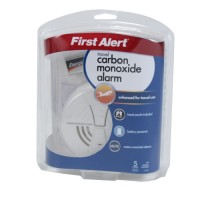Did you know?
Only about 30 per cent of Americans actually have an action plan for fire escape and have practiced it!
In case you hear your smoke alarm beeping, there is a reason, and it is advisable you evacuate the building immediately before the exit pathways are blocked by fire or smoke.
Depending on the smoke detectors installed in your home, you may get different warnings.
[yellowbox]For example, some interconnected talking smoke alarms will even warn you of the location of the fire and this is very advantageous because you have a rough or precise idea of where the fire was detected first.[/yellowbox]Fire spreads quickly! Although smoke alarms based on the photoelectric sensing technology are very sensitive to heavy particles of smoke and can detect smoldering fires that take some time before bursting into flames.
3 Helpful Tips that Could Save Your Life
1. If you are in a house with one or two levels of floors, invest in fire escape ladders. We recommend : Kidde KL-2S Two-Story Fire Escape Ladder with Anti-Slip Rungs, 13-Foot
We have a complete guide on the best portable fire emergency escape ladder.
2. Have a fire extinguisher to put off small fires. We recommend: Kidde 21005779 Pro 210 Fire Extinguisher, ABC, 160CI
Take advantage of this emergency safety package:
Stay festive & Safe with Emergency Safety Package, Kidde FA110 Multi Purpose Fire Extinguisher https://t.co/3notPlXxbU @amazon
— B.L.O.A.T (@BottomLineAlarm)
3. Plan and practice ahead with your family on how you will escape in case of a fire emergency. This builds up confidence and calmness when the real emergency situation happens.
Since the beeping of your smoke detector is the trigger of your emergency action plans, it cannot be emphasized more: the most important thing that you MUST ensure ALWAYS is that your smoke detectors are working properly. You can do this by testing them regularly – at least on a weekly basis by using the TEST button.
According to NFPA, having a functional smoke detector reduces chances of dying in a fire by 50 per cent!
4 of the Most Leading Causes of Fire
1. Cooking
2. Candles
3. Electrical
4. Smoking Materials like cigarettes
Some of the common causes of electrical fires are as a result of poorly designed circuits that do not meet electrical standards. Therefore, it is important that you ensure you engage the right people for this work.
Common mistakes include combining cookers, heaters and other appliances together with the lighting systems! Another causative factor is the use of low quality materials for high current protection e.g. circuit breakers, cables and lighting elements.
We would advise that if you are using a fluorescent tube that has a choke in its circuit, consider replacing with LED types that do not require the choke. The choke is known to be a leading cause of fire where electrical lighting was the cause of fire.
The bottom line is: BE PREPARED WITH A FIRE ESCAPE PLAN.
Visit our homepage to see a review of the best smoke detectors.











